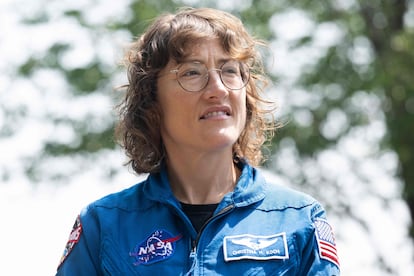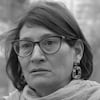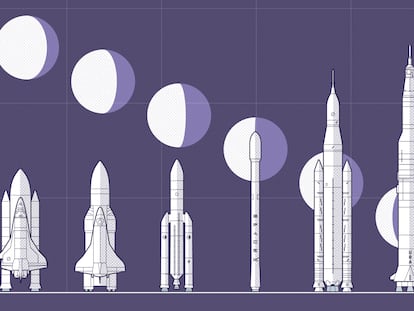Christina Koch: ‘When I told my kindergarten teachers I wanted to be an astronaut, they supported me’
The NASA specialist, who holds the record as the longest-serving female astronaut in space, will also become the first woman to travel to the Moon on the Artemis 2 mission


“Oooh, look, astronauts!” A group of tourists visiting Capitol Hill in Washington on Wednesday had the good fortune to bump into the crew of NASA’s upcoming Artemis 2 mission, the next phase of the agency’s program to land humans on the Moon again after a 53-year hiatus. The four astronauts, who had just concluded a series of meetings with members of Congress, agreed to take a few photos with them before their escorts guided them to the next event. “Did you see that? One of them was a woman!” they heard one of the admirers comment excitedly.
It is moments such as these that remind Christina Hammock Koch and the rest of her comrades, who recount the story, that the 44-year-old electrical engineer and physicist is going to make history — and that she has already become a role model for those who will follow in her footsteps. Koch will become the first female astronaut to travel to the Moon when the Orion spacecraft flies over our satellite next year as part of the Artemis program to resume manned missions to the lunar surface and pave the way for future travel to Mars.
Artemis 2 will be the most diverse mission in NASA’s lunar history. For the first time, it will involve not only a woman — 35.52% of the U.S. space agency’s workforce is female — but also an African-American astronaut, Victor Glover: only 11.83% of the institution’s employees are Black.
It will not be the first time that Koch has broken records. She is already the longest-serving female astronaut in space, spending 328 days on the International Space Station (ISS), and one of the members of the first all-female spacewalk, which took place in 2019. Two more would follow. In total, she has participated in six spacewalks, accumulating 42 hours and 15 minutes outside the base. She has participated in three expeditions to the ISS, and on the Artemis 2 mission she will have the role of specialist: it will fall to her to make sure that everything on the spacecraft works as it should.
The scientist acknowledges she feels a certain internal battle to promote her achievements as a woman who breaks records, and glass ceilings. Although she loves to share and to act as a mentor — and thus thank those who trained her — “I originally shirked away from the idea of talking about a record or number of days or those things. But I was actually taught by people that I talked to about it that milestones mean something to people. And sharing them helps educate where we are, the state of the art of human exploration. Inspiration for people that might be up against things that are challenging for them” she told EL PAÍS Wednesday during a meeting with the media at the Canadian Embassy in Washington.
Raised in Jacksonville, a small town in North Carolina, Koch always knew that she wanted to be an astronaut. She said as much as early as kindergarten during in an era — the 1960s and 1970s — when it was an unspoken requirement to be male and white to aspire to travel to space. “I feel fortunate that when I told my kindergarten teachers and all the teachers after that, that I wanted to be an astronaut they supported me. No one told me that that was unattainable. And whether it was my own hard-headedness or that encouragement, I did go full forward into pursuing my dream to become an astronaut,” she says.
The NASA specialist also attributes her determination to the examples set by her role models, pioneers in her field such as Sally Ride, the first American female astronaut, or Mae Jemison, the first Black astronaut to travel into space. She also cites people unrelated to the world of aeronautics, from the civil rights movement in North Carolina to her own grandmother in Michigan, a woman who “who basically ran an entire farm on her own, sent herself to college, despite her own father’s wishes against it, and never complained a day in her life and worked hard to basically contribute and give back. And even though I had never seen a female engineer in my small town in North Carolina, I did see people that believed in something and were brave enough to pursue what they believed in.” In her family, the astronaut adds, “hard work was held in the utmost of highest regard.”
Koch studied physics and electrical engineering before joining NASA at the Goddard Space Flight Center, where she contributed to the development of scientific instruments on several space missions. From there she moved to the U.S. Antarctic Program, where she spent an entire year — winter included — at the Amundsen-Scott South Pole Station.
After another stint in the world of scientific instruments for use in space, in this case at Johns Hopkins University, she returned to field work in other remote places, from Greenland to American Samoa. Unsurprisingly, she cites photography, travel, camping and climbing among her hobbies.
The ultimate fulfillment of her dream came in 2013, when she was selected as one of the eight members of Astronaut Group 21, a class that featured the same number of men and women, which was an unusual achievement: of the 360 astronauts selected by the U.S. space agency since its inception, only 61 have been women. Koch completed her astronaut training in 2015 and in 2018 she was assigned her first space flight, a long-stay mission on the ISS.
“Some of the advice that I’ve given people is to follow your passion. When you’re contributing to something that you’re truly passionate about, you’re going to be the most successful and you’re going to give the most back to the world,” she said during the visit to Congress on Thursday. “Do what scares you. And I say that because I think oftentimes the things that intrigued us, but that we think are just outside of our reach, are exactly the things we need to be doing. And the reason is when we achieve something that we thought we couldn’t, we actually give the most back to our world. And we find the most fulfilment, which drives us even further.”
However, Koch also says that there one that should never be forgotten: “Support the people around you. Make sure that you’re thinking about the success of those around you, that you’re helping them, and together we all will achieve as much as we possibly can.”
Sign up for our weekly newsletter to get more English-language news coverage from EL PAÍS USA Edition
Tu suscripción se está usando en otro dispositivo
¿Quieres añadir otro usuario a tu suscripción?
Si continúas leyendo en este dispositivo, no se podrá leer en el otro.
FlechaTu suscripción se está usando en otro dispositivo y solo puedes acceder a EL PAÍS desde un dispositivo a la vez.
Si quieres compartir tu cuenta, cambia tu suscripción a la modalidad Premium, así podrás añadir otro usuario. Cada uno accederá con su propia cuenta de email, lo que os permitirá personalizar vuestra experiencia en EL PAÍS.
¿Tienes una suscripción de empresa? Accede aquí para contratar más cuentas.
En el caso de no saber quién está usando tu cuenta, te recomendamos cambiar tu contraseña aquí.
Si decides continuar compartiendo tu cuenta, este mensaje se mostrará en tu dispositivo y en el de la otra persona que está usando tu cuenta de forma indefinida, afectando a tu experiencia de lectura. Puedes consultar aquí los términos y condiciones de la suscripción digital.
More information
Archived In
Últimas noticias
Most viewed
- Sinaloa Cartel war is taking its toll on Los Chapitos
- Reinhard Genzel, Nobel laureate in physics: ‘One-minute videos will never give you the truth’
- Oona Chaplin: ‘I told James Cameron that I was living in a treehouse and starting a permaculture project with a friend’
- Why the price of coffee has skyrocketed: from Brazilian plantations to specialty coffee houses
- David King, chemist: ‘There are scientists studying how to cool the planet; nobody should stop these experiments from happening’










































